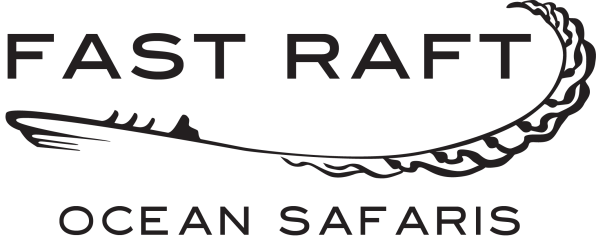Person
Ages 8 and up
$ 195
Monterey Bay Ocean Safari
Monterey Winter Wildlife Safaris are the best way to experience our resident sea otters, seals, dolphins, and sea lions, migrating seabirds, and the “gray whale highway” that hugs our gorgeous rocky coastline.
Monterey’s protected harbor puts us close to the marine life sightings that concentrate around the Monterey Peninsula in winter. It’s also a lovely port with clear water, colorful invertebrates under the floating docks, and our warm, welcoming office in Breakwater Cove Marina.
Winter-Spring Migration Season Species:
- Seabirds like fulmars, shearwaters, auklets, loons, and phalaropes
- Harbor seals, California sea lions, and sea otters (year-round)
- Gray whales following the coast from the Bering Sea to breed in Baja
- Overwintering humpback whales
- Killer whales hunting gray whale calves in April and May
- Six species of dolphins
- Tell us what you want to see, and we’ll try to find it!
A Fast Raft Winter Wildlife Safari is an incredible experience in the famous Monterey Bay National Marine Sanctuary. Your knowledgeable naturalist and captain will not only make sure you get the best sightings and photographic angles, we’ll teach you about the lives of the marvelous animals that call our ocean home. All our tours are customized for the six people on board, so let us know what you want to see and we’ll do our best to take you there!
Winter Weather
Winter weather here is usually sunny and brisk between rainy storms, and temperatures stay above freezing. The sea is usually bouncier than in summer, so come prepared for motion. There’s nothing so beautiful as waves hitting the rocky shore so bring your camera. If you can, plan a couple of flexible days in town in case we need to let a storm pass by.
Where Does the Monterey Wildlife Safari Go?
Every tour passes Cannery Row and the Monterey Bay Aquarium, where sea otters forage in the kelp forests and seals snooze on rocks. Usually we follow the Pacific Grove shoreline to Point Pinos, a gathering point for migrating seabirds and gray whales that cross the Bay. We may explore into open water, or hug the coast for captivating views of Asilomar and Cypress Point. Longer tours on calm days may venture into Carmel Bay and visit the stunning cliffs of Point Lobos.
Trip Length
- Three hours is standard, and longer trips are labeled in the booking calendar
- Three hours is usually enough to find and enjoy the best sightings
- Four-hour trips allow longer observation and looking for more species
- All-day tours are open-ended, usually at least six hours, customized to the wildlife enthusiasts on board
- For all-day trips, pack a lunch and be comfortable with backwoods restroom accommodations
What’s Included
- Your captain and naturalist for the day
- Use of waterproof jackets and pants, and dry-bags for cameras
- Comfortable Mustang self-inflating life vests
What’s Not Included:
- Food and drinks are not included. Feel free to bring snacks.
- Gratuities are always appreciated for a job well done.
Day of Your Tour:
- Arrive half an hour early to pay for parking, use the restroom, and put on your warm jackets.
- Be ready for our safety briefing that starts 15 minutes before departure.
Seasickness
It’s your responsibility to come prepared. If you’re sensitive, or have never been on the open ocean, please start medication the day before. In the US both Dramamine and Bonine are available at any drug or convenience store. There are more tips on our website FAQs and feel free to email us with questions. Thank you!
Meeting Location:
- Fast Raft office in Breakwater Cove Marina (note: we’re not on Fisherman’s Wharf)
- Our quiet location is a great place to watch sea otters and sea lions
- Be sure to pay for parking plus an extra hour
What makes us so unique and different from other boats is our vessel. Our “Ranger” provides a low to the water, open platform that is ideal for wildlife viewing and photography. We can easily travel faster than other boats, allowing us to reach spectacular destinations and wildlife in a shorter time, though we are careful to moderate our speed in respect for the wildlife. Once we stop to enjoy a sighting, our engines are nearly silent at idle, and we often turn them off to soak in the natural sounds.
